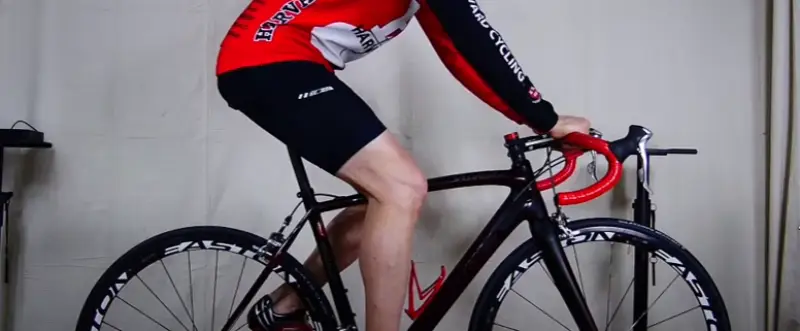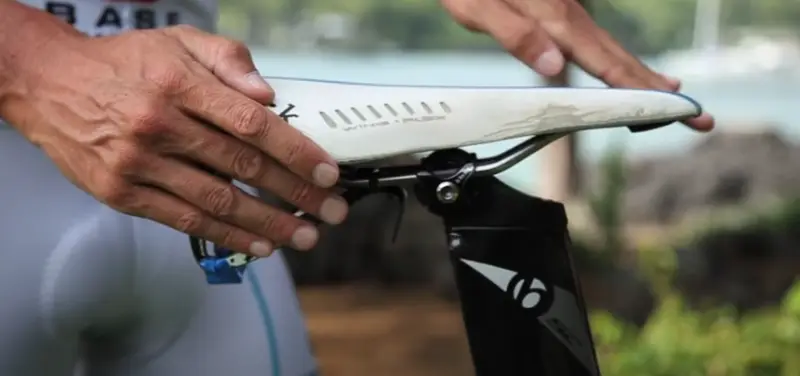Gluteal tendinopathy occurs when the tendons of the gluteal muscles break down or deteriorate. Chronic gluteal tendinopathy can cause chronic, severe pain. This condition can adversely affect work, exercise, and socialization. If it interferes with sleep, the pain may cause fatigue and irritability.
Yes, cycling impacts the gluteal muscles. Exercises for gluteal tendinopathy stimulate your tendons to heal and strengthen. However, the cyclical action may occasionally irritate outer hip pain. If you are keen on cycling while recovering from gluteal tendinopathy, try a very gentle and short ride first.
In this blog post, we will explain the relationship between cycling and gluteal tendinopathy and how one might aid in recovery from the other. We’ll explore how cycling affects the gluteal muscles and how this low-impact exercise can contribute to overall rehabilitation and recovery.
Is Cycling Good For Gluteal Tendinopathy: 5 Effects

The gluteal tendinopathy affects the tendons around the gluteal muscles, causing pain, stiffness, and reduced mobility in the hip region. While traditional treatments like rest, physical therapy, and medication are often recommended, cycling can offer significant benefits for people with gluteal tendinopathy. Here are some impacts of gluteal tendinopathy and contributes to overall rehabilitation and recovery.
Strengthening Your Glutes
Exercises like cycling have a low impact on the gluteal muscles, particularly the gluteus maximus, medius, and minimus. These muscles are crucial in stabilizing the pelvis and supporting the hip joint.
People with gluteal tendinopathy can strengthen these muscles by regular cycling without putting excessive strain on the tendons. Stronger glutes can help improve hip stability, reduce stress on the affected tendons, and enhance overall function in the hip region.
Enhancing Circulation
Cycling promotes blood circulation, a key benefit for people with gluteal tendinopathy. Enhanced circulation facilitates the delivery of nutrients and oxygen to the affected tissues, facilitating healing.
Moreover, cycling increases the release of endorphins, a natural pain-relieving hormone that relieves gluteal tendinopathy-related discomfort. The rhythmic cycling motion also reduces inflammation and tissue repair in the gluteal region.
Muscle Strain
Cycling allows riders to engage in controlled movements while minimizing the risk of overloading their tendons. The controlled environment is particularly beneficial to those with gluteal tendinopathy, as it helps prevent excessive strain on the already compromised tendons.
By adjusting the intensity and duration of cycling sessions, cyclists can gradually build strength in their glutes without exacerbating their condition. Proper bike fitting and posture can help minimize muscle strain and ensure optimal engagement during cycling.
Hip Tendinopathy
Hip tendinopathy, which causes pain and inflammation in the tendons surrounding the hip joint, is often associated with gluteal tendinopathy. Cycling can benefit patients with hip tendinopathy by allowing them to slip in the hip joint and strengthening the supporting muscles.
Repetitive motion during cycling can improve hip flexibility, range of motion, and function, contributing to better hip health and reducing tendinopathy discomfort.
Lateral Hip Pain
Cycling can help alleviate lateral hip pain by targeting the gluteus medius, a muscle located on the outer part of the hip that plays a crucial role in hip stabilization and abduction. By engaging the gluteus medius through cycling, people can improve muscle strength and endurance in this area, reducing the likelihood of experiencing lateral hip pain during daily activities.
The smooth, continuous cycling motion also helps increase flexibility and loosen tight muscle regions, further reducing discomfort.the hip region, further reducing discomfort and enhancing mobility.
Cycling with Gluteal Tendinopathy: 10 Safety Tips
Gluteal tendinopathy, characterized by pain and inflammation of the tendons in the gluteus, can be aggravated by certain movements, including cycling.
By following specific safety tips and precautions, cyclists with gluteal tendinopathy can continue to enjoy their rides while minimizing discomfort and reducing the risk of further injury. Here are some safety tips:
Proper Bike Fit

Fit your bike correctly to minimize strain on your gluteal tendons. Adjust the saddle height, position, and handlebars to promote a comfortable cycling posture and reduce pressure on sensitive areas.
Warm-Up and Stretch
Before starting your ride, engage in a proper stretching and warm up routine. Focus on dynamic stretches for the hips, hamstrings, and glutes to improve flexibility and circulation.
Gradual Progression
If you’re recovering from gluteal tendinopathy, avoid sudden increases in activities such as long rides. Gradually build up your cycling regimen to allow your body time to adapt and avoid overloading the affected tendons.
Cadence Management
Maintain a consistent cadence while cycling to reduce stress on the gluteal tendons. Try maintaining a cadence of 70-90 revolutions per minute to promote smoother pedal strokes and minimize muscle strain.
Seat Position
Pay attention to your seating position on the saddle. If you lean too far forward or backward, you may increase pressure on the gluteal tendons. Maintain a neutral spine alignment for optimal comfort and support.
Standing Intervals
Incorporate standing intervals during your rides to relieve pressure on the gluteal tendons. Alternate between sitting and standing to distribute workload and prevent overuse of specific muscle groups.
Cross-Training
Supplement your cycling routine with cross-training activities that enhance hip and gluteal strength. Include exercises such as hip abductions, clamshells, and bridges to improve stability and support.
Cool Down and Recovery
After completing your ride, cool down and stretch your lower body muscles. Perform static stretches focusing on the glutes, hamstrings, and hip flexors to promote flexibility and reduce muscle tension.
Nutrition and Hydration

Stay hydrated before, during, and after your ride to support muscle function and recovery. Providing your body with nutrients rich in vitamins and minerals will assist in muscle repair and reduce inflammation.
Listen to Your Body
Be aware of any discomfort or pain you experience during your rides. If you experience increased pain in the gluteal region, consider reducing the intensity or duration of your cycling sessions and consult with a healthcare professional if necessary.
Cycling Alternatives Best Exercises For Gluteal Tendinopathy
Gluteal tendinopathy, a common condition characterized by pain and dysfunction in the gluteal tendons, can be debilitating. However, targeted exercises are crucial in managing and rehabilitating this condition. Here are some cycling alternatives for the best exercise for gluteal tendinopathy.
Bridge
The bridge exercise is a fundamental movement that targets the gluteal muscles, including gluteus maximus, minimus, and medius. To perform a bridge:
- Put your feet on the ground and lay on your back.
- Engage your core muscles and lift your hips to form a straight line.
- Hold this position for a few seconds before lowering back down.
- This gentle exercise can be performed five to 10 times daily.
Step Ups
Step-ups are another beneficial exercise for patients with gluteal tendinopathy as they target the gluteal muscles and improve functional strength. To perform step-ups:
- Stand in front of a step or platform.
- Place one foot on the step, ensuring your entire foot is on it.
- Push through the heel of the top foot to straighten the leg and lift your body up onto the step.
- Step back down and repeat on the other side.
- You should try this thrice daily, each for 30 to 60 seconds.
Static abduction
Static abduction exercises target the gluteus medius, a key muscle in hip stability and function. To perform static abduction:
- Lie on your side with your legs stacked on top of each other.
- Legs should be raised towards the ceiling while keeping the knee straight.
- Try this at least once a day to increase your flexibility gradually.
Single Leg Standing Stretch

The single-leg standing stretch improves flexibility and mobility in the hip region, especially for people with gluteal tendinopathy. To perform the single-leg standing stretch.
- Place one leg on a stable surface for support.
- Bend the other knee and bring the heel towards the buttocks.
- Hold this position to feel a gentle stretch in the thigh’s front and hip.
- Repeat the stretch with the other leg.
Single Leg Squat
Single-leg squats are advanced exercises that help improve strength, stability, and balance for those with gluteal tendinopathy. To perform a single-leg squat:
- One leg should be extended slightly forward.
- Slowly lower your body by bending the standing leg at the knee and hip.
- Keep the chest up and the core engaged throughout the movement.
- Push through the heel to return to the starting position.
Forward and Side Hopping
Forward and side hopping exercises are dynamic movements that help improve agility, coordination, and power in the lower body, making them beneficial for gluteal tendinopathy. To perform forward and side hopping:
- Start in a semi-squat position with knees slightly bent.
- Hop forward or to the side, landing softly on both feet.
- Immediately hop back to the starting position.
- Continue hopping back and forth in a controlled manner.
Conclusion
Cycling may be your secret weapon in your battle against gluteal tendinopathy. It’s not just a mode of transport or a recreational activity but a potent, low-affected exercise that can contribute significantly to the rehabilitation and recovery of this condition. Every journey begins with a single step or pedal, in this case, and it’s pivotal to do it right.
Follow the safety tips and precautions to prevent exacerbation of pain and inflammation. Now, if you want to explore beyond the cycling realm, an array of alternative exercises awaits your discovery. Gluteal tendinopathy might sound like a long, uphill ride. But with the right approach, a smooth ride to health and strength is just a bike ride away.
FAQs
How Is Gluteal Tendinopathy Treated?
- The painful area can be relieved by applying heat.
- Stair climbing should be minimized.
- Make sure your legs are not crossed.
- Pillows between the knees during sleep.
- Keep flat surfaces in mind when walking.

![Five Effects of Cycling on Gluteal Tendinopathy and 10 Safety Tips [6 Alternative Exercises]](https://cacyclinghub.com/wp-content/uploads/2025/07/Five-Effects-of-Cycling-on-Gluteal-Tendinopathy-and-10-Safety-Tips-6-Alternative-Exercises.webp)
